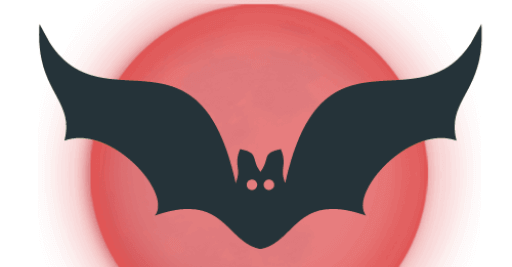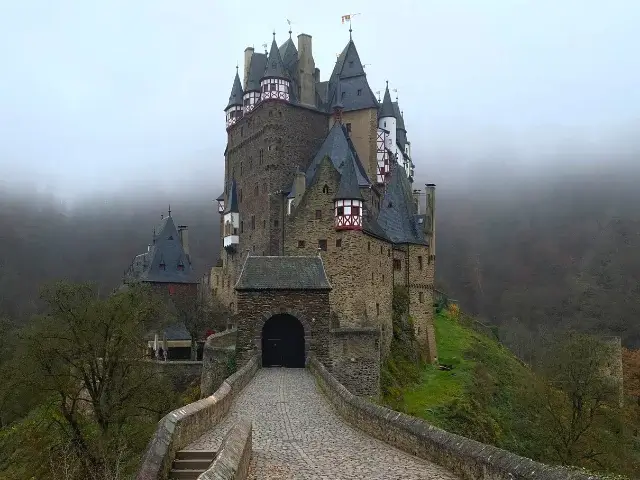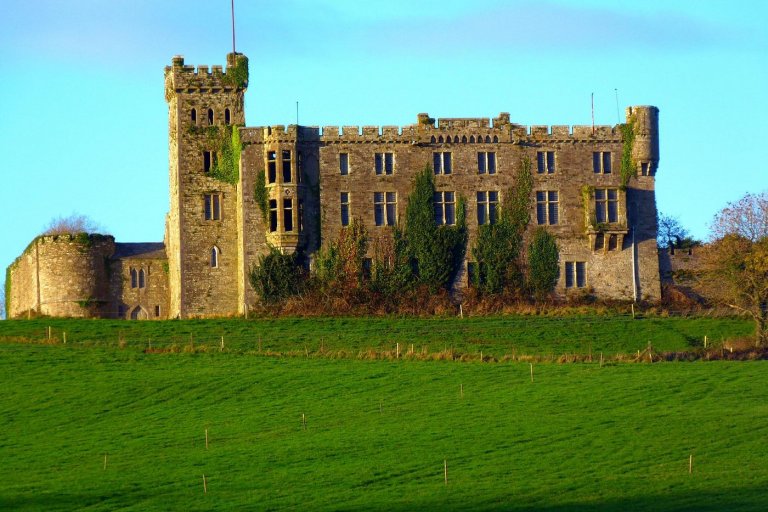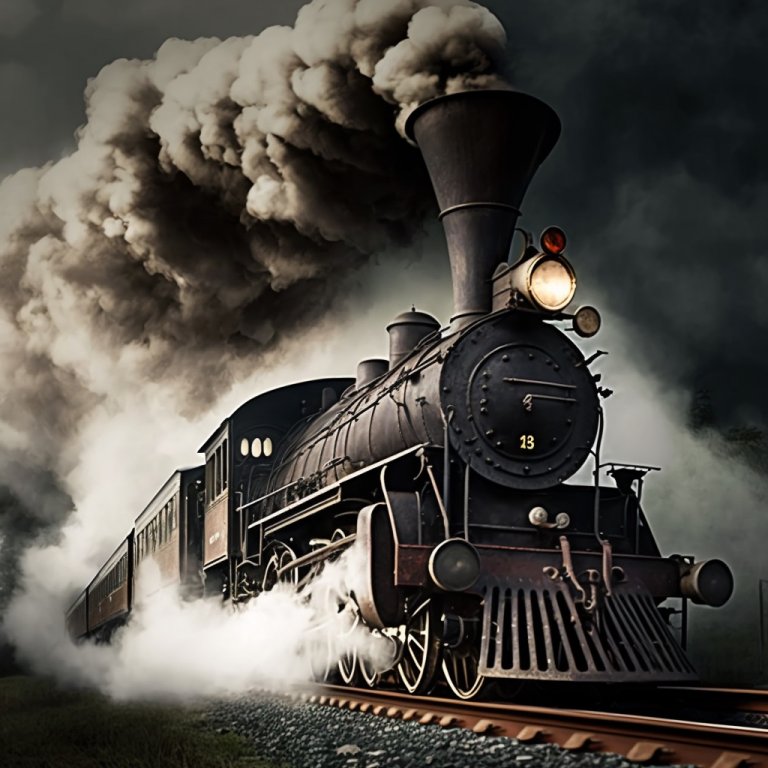The 10 Most Haunted Castles in Germany
Do you love a good ghost story? If so, then you’ll love visiting one of Germany’s most haunted castles. From Bavarian castles to Gothic ruins, these eerie places are filled with stories of spooks, specters, and even witches. So if you’re looking for a thrilling trip that will keep you up at night, be sure to add these haunted castles to your list!
It’s no secret that the Germans are close-mouthed about their ghosts. They pretend it’s because they find ghosts silly and Halloween too commercial and Americanized. But, based on the number of ghost stories we’ve found about haunted places in Germany, there must be something going on here.
Why are the Germans so careful not to talk about their ghosts?
Without further ado, here are the 10 most haunted castles in Germany
1. Neuschwanstein Castle
Neuschwansteinstraße 20, 87645 Schwangau, Germany

Neuschwanstein Castle stands on a rocky hill above the village of Hohenschwangau, in the southwest of Bavaria. It is the fairytale castle that served as the inspiration for the Disney castle and is possibly the most beautiful castle in the country, if not Europe.
Neuschwanstein is also is reputed to be one of the most haunted places in Germany.
King Ludwig II of Bavaria built the palace to honour Richard Wagner intending it as a refufe where the composer could relax. Needless to say, there are claims that Wagner haunts the castle.
Ludwig used his own money and borrowed a lot to pay for it. Building began in 1869 and the castle was the King’s private home until he died in 1886.
It is now open to the public. Over 61 million people have been to Neuschwanstein Castle since then. Every year, over 1.3 million people come, and in the summer, 6,000 people visit every day.
When you visit the beautiful and historic Neuschwanstein Castle, be sure to keep an eye out for the ghosts.
People say that the ghosts sometimes look like pale figures or silhouettes that float down from the turrets or hover over flower beds. If you’re brave enough to venture into the haunted halls, be prepared for a creepy experience!
Over the years, dozens of people report seeing apparitions and strange phenomena at Neuschwanstein. Some say they’ve heard wailing from inside the castle walls; others have seen shadowy figures moving about its turrets or even climbing up to its rooftops.
During the Second World War, the Nazis looted art from all the countries they conquered. Neuschwanstein Castle was the headquarters of the Nazi art-looting organization.
Today, people who go to Neuschwanstein Castle are told not to go alone after dark because it is said to be home to ghosts who want to get back at Ludwig II and his family for wrongs they did long ago.
No matter which theory you subscribe to, one thing is certain: visitors will never forget their experiences at Neuschwanstein Castle…
2. Frankenstein Castle
Burg Frankenstein, 64367 Mühltal, Germany

Frankenstein Castle is a hilltop castle in the Odenwald that looks out over the city of Darmstadt. This castle might have given Mary Shelley ideas for her Gothic novel Frankenstein, which she wrote in 1818.
Her inspiration might have been Johann Konrad Dippel, an alchemist, who was born at the castle in 1673. From the time she wrote Frankenstein, Mary Shelley did not mention Dippel in her journals. However, Shelley did visit the Rhine in 1814, which was just before she wrote her best-selling novel.
Dippel may have practiced alchemy, studied anatomy, and exhumed dead bodies. There are rumors he dug up corpses and did medical experiments at the castle, and a local priest aclaimed Dippel had created a lightning-powered monster. (The 1931 film uses lightning to bring Frankenstein’s monster to life; the novel doesn’t.)
Local folk say that this really happened and that the Brothers Grimm told Shelley’s stepmother about it, hence her writing about it in Frankenstein.
On Halloween night in 1952, John Keel sent three reporters from the American Forces Network to Frankenstein Castle to do a live radio report about the castle. The reporters were told that local legend said that Frankenstein’s monster would come back to the castle that night.
Carl Nelson, a reporter, went into the castle’s crypt. As a joke, Keel had “set up a statue in the middle of the crypt and set it up to move and fall,” which scared Nelson. Terrified radio listeners reportedly calledin to the station and causes such a fuss that military police were sent to the castle.
In 2008, the SyFy TV show Ghost Hunters International made an entire episode about the castle (Episode 107) and said it would show “significant paranormal activity.”
This got the castle a lot of attention around the world. Ghost Hunters recorded sounds coming from the chapel and the tower by the entrance sounded like words, and an ultrasonic recorder picked up signals in the chapel.
A recorded sound was found to be an Old German phrase that means “Arbo is here.” This was interpreted as “Arbo” probably meaning “Arbogast,” the name of a knight of the castle, claiming the land and letting everyone know he was there. A second piece of sound was taken to mean “come here.”
When the team left Frankenstein Castle, they were sure that something strange was going on there.
3. Königstein Castle
01824 Königstein, Germany
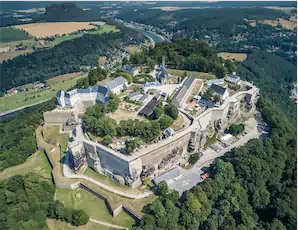
Konigstein Fortress is near Dresden, Germany. It is on the left bank of the River Elbe, above the town of Konigstein, and looks out over the river. It is one of the biggest hilltop forts in Europe.
The property has been the subject of many reports of ghost sightings and other supernatural phenomena, dating back to at least 1548.
Today, visitors continue to report strange happenings, including apparitions, and feelings of being watched. Some have even reported hearing voices or seeing people who disappeared long ago walking around the castle grounds.
There are many theories about what might be happening at Königstein Castle: some say it’s home to ancient beings such as spirits from hell; others believe the castle is cursed by someone angry with its previous owners; still others think that occult activity is responsible for all the weirdness.
Tourists have been visiting Königstein Castle since its opening as a tourist site in 1895, and reports of ghostly activity have only increased. Some say they’ve seen apparitions of ladies in white gowns walking down darkened corridors, while others claim to hear sobbing or moaning coming from various parts of the property.
Whatever the truth may be, it’s clear that Königstein Castle holds secrets worth exploring! If you’re interested in investigating these claims for yourself, be sure to schedule a visit soon – paranormal activities increase during Halloween season!
4. Ortenberg Castle
Burgweg 21, 77799 Ortenberg, Germany
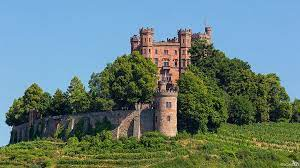
Ortenberg Castle is the major landmark of the Ortenau. It is located above the town of Ortenberg, at the end of the Kinzig Valley, between Offenburg and Gengenbach.
The first records of the Ortenau Castle are from the 11th or 12th century. The House of Zahringen built the castle to protect the Kinzig Valley. The castle is now a place for young people to stay.
Ortenberg Castle is one of the most haunted places in Europe, and it’s no wonder!
The castle has been home to several infamous historical figures, including Maria Theresa of Austria (the first queen regnant of Hungary), Count Ferenc II Rákóczi (the leader of the Hungarian Revolution of 1848-49), and Emperor Franz Joseph I.
There are countless stories about Ortenberg Castle ghosts, some more believable than others. Some say that the ghost of Emperor Franz Joseph I still haunts the castle grounds, seeking vengeance for his death at the hands of revolutionaries.
Others believe that Baroness Erzsébet Báthory (the blood-drinking proto-vampire) was executed here in 1610, and her spirit lingers to this day. And even more people claim to have experienced paranormal activity, such as sightings or heard strange noises at Ortenau Castle.
There are said to be all sorts of weirdness going on at Ortenberg Cstle – from apparitions of people who have died in violent accidents to cold spots that appear only when no one is around. Some even claim to have heard voices and see shadows moving about during their visits.
Whatever the case may be, there’s no denying that Ortenberg Castle is a truly mysterious place… and its ghosts just keep getting creepier!
5. Hohenschwangau Castle
Alpseestraße 30, 87645 Schwangau, Germany
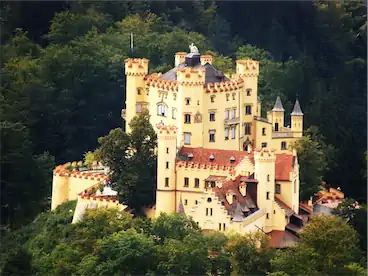
Hohenschwangau Castle, is a palace in southern Germany that was built in the 19th century. It was where King Ludwig II of Bavaria lived when he was a child. His father, King Maximilian II of Bavaria, built it.
Haunted Hohenschwangau Castle is one of the most famous haunted castles in Europe. It has been featured on many shows, including Ghost Adventures, The Most Haunted, and Fear Factor.
Built in 1220 by Count Otto IV of Wittelsbach (the first royal patron of Gothic art), the castle was originally called Ravensburg Castle because of its dark walls.
Over time, it became known as Hohenschwangau after a nearby river was renamed after Frederick II (Hohenstaufen).
Lots of paranormal activities are reported from inside Haunted Hohenschwangau Castle…from curses cast by angry spirits to hidden mysteries waiting to be discovered. No matter what you believe, there’s no denying that this place is truly haunted!
The Haunted Hohenschwangau Castle plays host to one of the most spine-tingling tours in all of Germany. This stunning palace is said to be haunted by the ghosts of its former occupants, including a young princess who was murdered and her lover who committed suicide. The tour guides say that you can feel their anger and sadness as they wander through the castle.
If you’re brave enough to take this terrifying tour, be prepared for stories that will stay with you long after your visit has ended.
6. Hohenzollern Castle
72379 Burg Hohenzollern, Germany
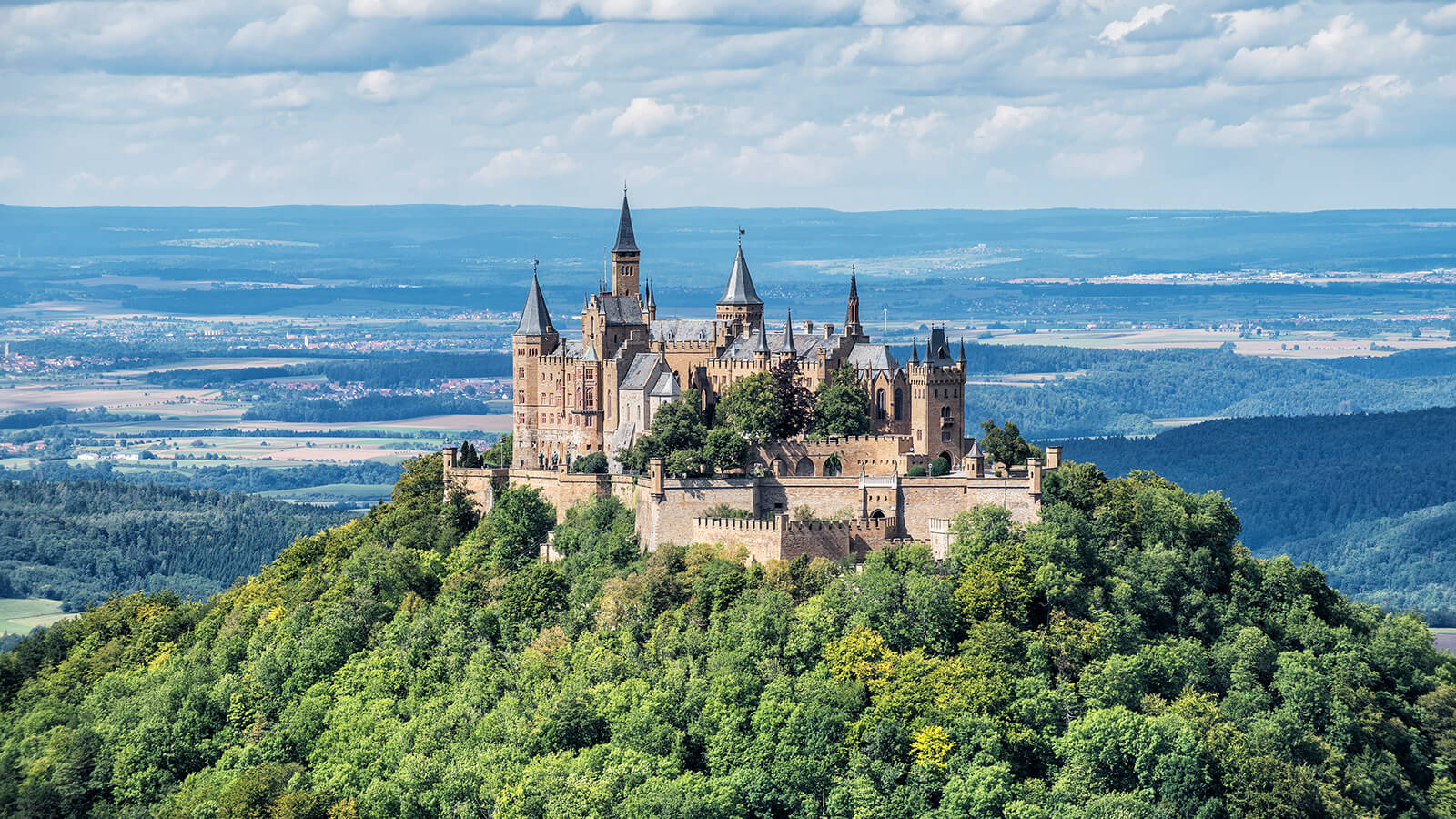
The imperial House of Hohenzollern had its roots at Hohenzollern Castle It is on the top of Mount Hohenzollern, above and south of Hechingen, on the edge of the Swabian Jura in central Baden-Württemberg, Germany. It is the third hilltop castle to be built on the same spot.
At the beginning of the 11th century, the first castle was built on the mountain. The House of Hohenzollern split up several times over the years, but the castle stayed with the Swabian branch.
From 1454 to 1461, the second castle, which was bigger and stronger, was built. It was a safe place for the Catholic Swabian Hohenzollerns, even during the Thirty Years’ War. By the end of the 18th century, it was thought to have lost its strategic value, and it slowly fell into disrepair, causing several old buildings to be torn down.
Between 1846 and 1867, King Frederick William IV of Prussia, a Hohenzollern descendant, built the third and current castle as a family memorial. Friedrich August Stüler based his design on English Gothic Revival architecture and the Chateaux of the Loire Valley.
In 1945, it was briefly the home of the son of the last Hohenzollern monarch, Kaiser Wilhelm II, the former Crown Prince Wilhelm of Germany.
Hohenzollern Castle is one of Germany’s most famous and haunted castles. Over the years, it has been the scene of several strange and eerie events, which have left many visitors feeling uneasy. Here are some of the most famous ghost stories from the castle:
The Green Lady
In 1546, Catherine de’ Medici invited her former maidservant to live with her at Hohenzollern Castle. Shortly after taking up residence, she began experiencing odd paranormal activity that led her to believe that someone was trying to kill her. One evening, while she was getting ready for bed, she saw a green figure looming over her in the mirror. Terrified but paralyzed with fear, she could do nothing as this spectral woman slashed at her throat with a bloody knife before ‘disappearing into thin air.’
The White Lady
Another story tells of an imprisoned noblewoman who sees herself wearing only white court dress when she dies in prison. The White Lady spends eternity agonizing over whether to confess all she knows about corruption within high society during her lifetime, so that others might also be saved from unjust imprisonment and death..
One of the most popular legends tells of an old woman named Anna who was brutally murdered in one of the castle’s guestrooms. Her spirit still haunts the room to this day, lashing out at anyone who enters it. Another story involves a young nobleman named Hans whose body was found floating in a well on top of the castle after he had apparently committed suicide. His ghost continues to wander around the corridors and rooms near his deathbed, seeking vengeance against those responsible for his death.
There are many other supernatural tales that take place inside Hohenzollern Castle – some more plausible than others! If you’re brave enough to visit this infamous location, be prepared for anything!
7. Eltz Castle
56294 Wierschem, Germany
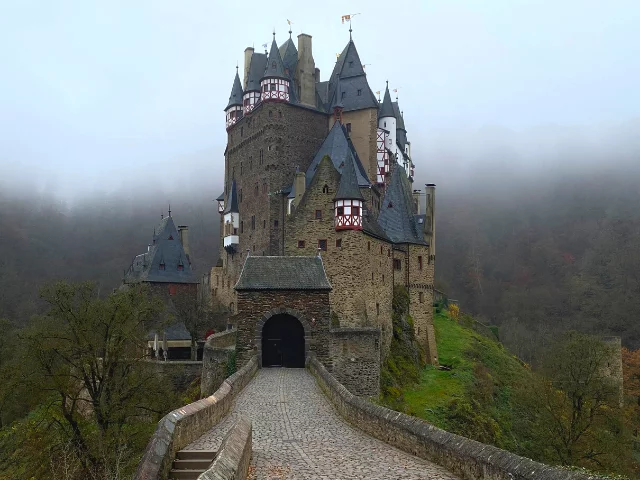
Eltz Castle is a medieval castle nestled in the hills above the Moselle River between Koblenz and Trier in Germany. A branch of the House of Eltz, which has lived there since the 12th century, still owns it.
The castle is on a 70-meter-high (230-foot) rock spur that is surrounded on three sides by the river Elzbach, which flows into the Moselle from the north. Flora-Fauna-Habitat and Natura 2000 have made the Eltz Forest and the surrounding land a nature reserve.
Burg Eltz is a beautiful but spooky place. It has been the setting for many ghost stories over the years, and it seems like every visitor leaves with at least one tale to tell.
Here are some of the creepiest Burg Eltz castle ghost stories you might share next time you visit:
The Lady in White
This story goes that an old lady who was working at the castle died suddenly. Her body was found floating in a moat outside of the building, and she seemed to have drowned accidentally. Since then, staff members have reported seeing her wandering around the grounds late at night dressed in white robes. Some say she even makes peaceful vocalizations occasionally, as if trying to speak to those who see her.
The Grey Lady
Another popular legend concerns a grey-clad woman named Agnes whose husband died young several years ago. Unable or unwilling to cope with her grief, Agnes took her own life by jumping from one of Burg Eltz’s towers after dark with only enough food for herself for three days without water or shelter. Ever since that fateful day, visitors report hearing heavy footsteps followed closely by an eerie chilly breeze on warm nights inside the castle walls – especially near where Agnes supposedly landed after making her escape from death row!
Burg Eltz castle is one of the most enigmatic and spooky places in Germany. Legend has it that the castle is haunted by ghosts of its past inhabitants, including a witch who killed her own children and a prince who was cursed to die an untimely death.
Witnesses have reported seeing strange lights and hearing eerie sounds from inside the castle walls. Although no solid evidence exists to support these claims, there’s something about Burg Eltz that makes it impossible to ignore – even for the bravest ghost-hunters!
There are undoubtedly many other creepy tales connected with Burg Eltz Castle – so be sure to ask your tour guide about any specific legends they know about when you visit!
8. Heidelberg Castle
Schlosshof 1, 69117 Heidelberg, Germany
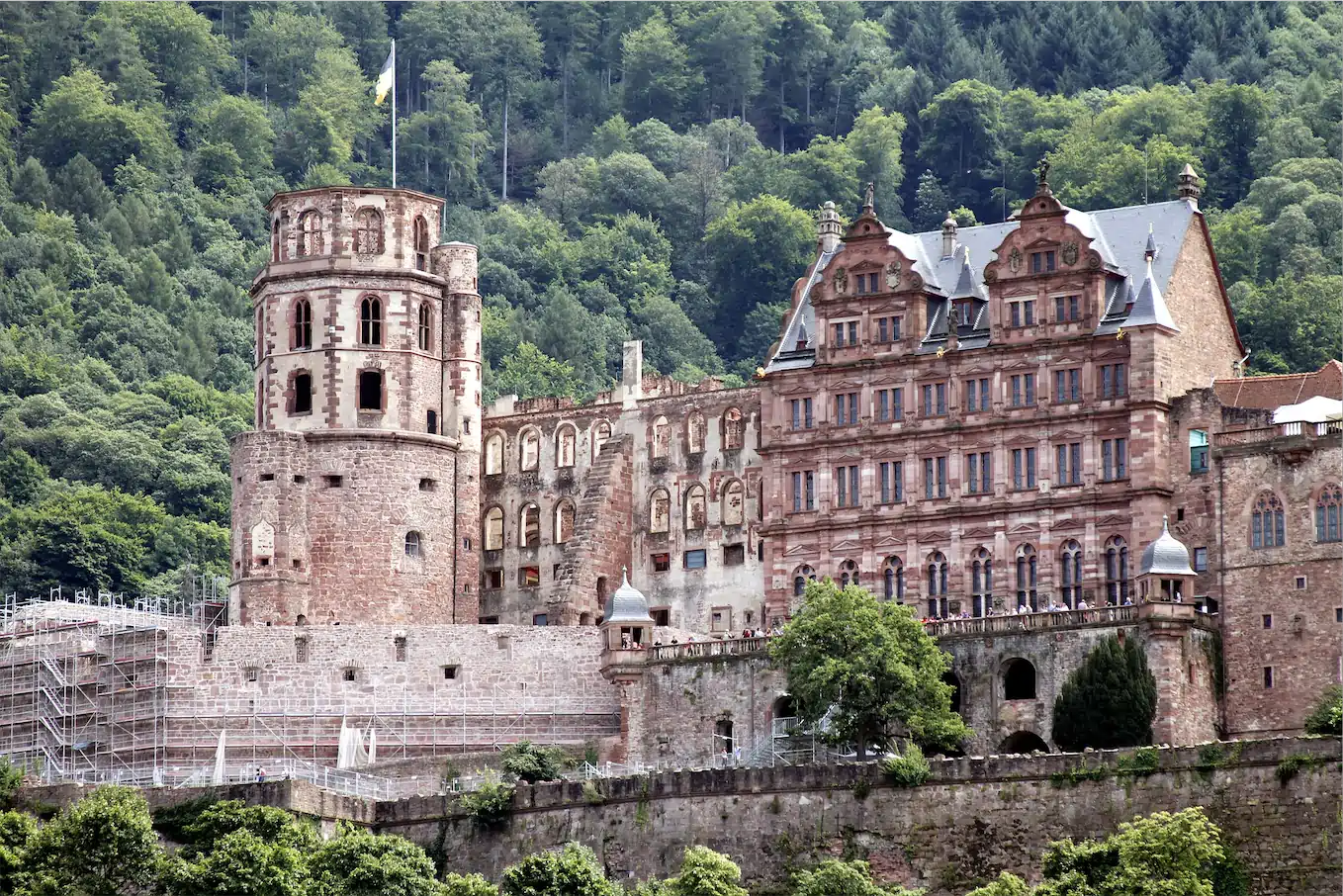
Heidelberg Castle is a ruin in Germany and landmark of Heidelberg. The ruins of the castle are some of the most important Renaissance buildings north of the Alps.
The castle was originally built by a wealthy family in the 13th century, and over the years it has been used as a residence, fortress, hospital, and even a prison. It has also played an important role in German history, serving as the official residence of the Electors (the rulers) of the Palatinate for over 500 years.
Since it was torn down by the French Army in the 17th and 18th centuries, only part of the castle has been rebuilt. It is 80 metres (260 feet) up the north side of the Konigstuhl hill, so it has the best view of the old city centre.
Before 1214, the first castle was built. Around 1294, it was split into two castles. In 1537, a lightning strike destroyed the upper castle. By 1650, the buildings we see today were already bigger than they were before wars and fires hurt them. In 1764, another lightning strike started a fire that burned down some of the rebuilt parts.
The Alchemist’s Ghost
Heidelberg Castle is allegedly haunted by the ghost of an alchemist.
The story goes the alchemist was working on a secret formula when he suddenly went mad. He locked himself in one of the castle’s towers and threw himself from the window. His body was never found, and it is believed that his ghost still wanders the halls of the castle, searching for the answer to his ultimate question.
In the gate tower of Heidelberg Castle, there is still a heavy wooden door. People used to get in through a small gate that was cut into the door. A big iron ring was used as a knocker to let the guard know that someone was at the door. The story in Heidelberg was that whoever could bite through the iron ring would inherit the castle and everything in it.
The iron ring on the gate tower is missing a piece. The reason for this is that a witch tried to bite through the iron ring so she could own the castle. But her magic wasn’t enough, and when she bit down on the hard metal, her teeth broke. She left Heidelberg Castle because she was angry. She left behind the “Witch’s Bite” as proof that she had tried to open the front gate.
There is also a Witch Tower in Heidelberg town which is worth visiting.
Whether you believe in ghosts, there is no denying that Heidelberg Castle has an eerie aura about it. And who knows? Perhaps the ghost of the alchemist is still lurking around, hoping finally to solve his mystery.
9. Reichenstein Castle
Burgweg 24, 55413 Trechtingshausen, Germany
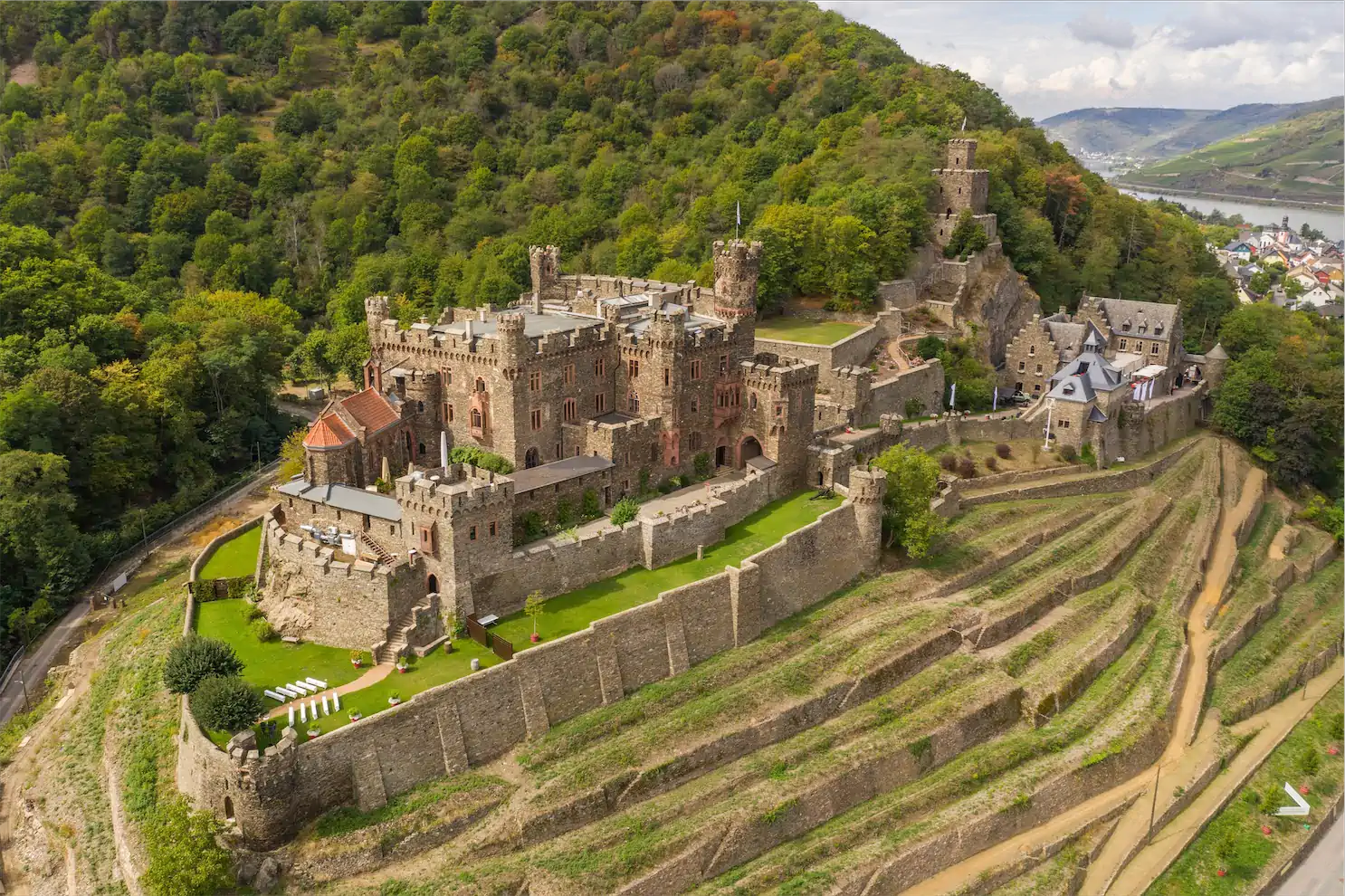
Reichenstein Castle, also called Falkenburg, is a castle in the Upper Middle Rhine Valley on a mountain spur on the eastern side of the Bingen Forest.
It was built to protect a nearby village and has gone through different stages of siege, destruction, and repair over the years.
People say that a robber baron named Dietrich von Hohfels and his nine brothers used the castle as a safe place to live. Right after they were arrested, he asked the court to let their sons go free. The court said no.
Several people were killed, and von Hohfels’ head was cut off and he was buried in the chapel of St. Clement in the castle. People say that his headless spirit still haunts the castle.
Another legend of the ghosts of Reichenstein Castle is one of Germany’s most spine chilling tales. The castle is said to be haunted by the spirits of a dead young noblewoman who was killed in a brutal murder spree over 200 years ago.
Since then, the woman has lingered, seeking revenge on her killers. Some say that she is still seen wandering its corridors and chambers at night, searching for her bloodstained clothes and jewels. Others claim to have even heard her screams echoing through the old building…
10. The Berlin Citadel
Am Juliusturm 64, 13599 Berlin, Germany
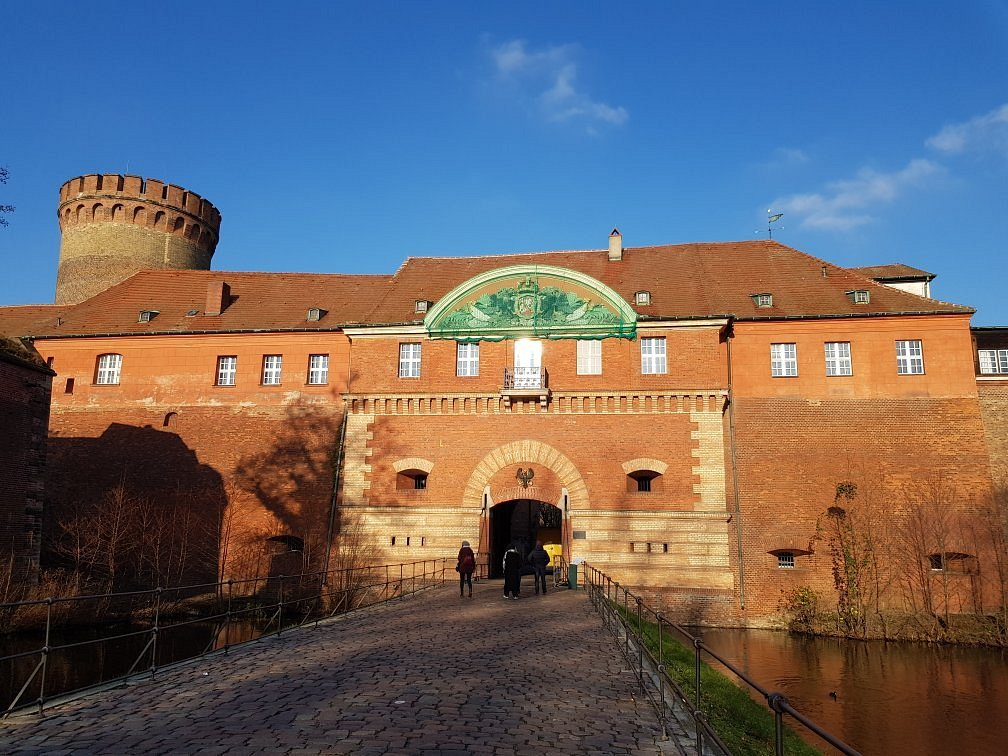
The impressive Zitadelle Renaissance fortress at Berlin’s Spandau Citadel has a long and complicated history. It was once a military fortress and is now a cultural centre and concert hall.
The site was once home to a castle built in the 1300s. Since the only building left from that complex is the Julius Turm tower, it is now Berlin’s oldest building. At 34.6 meters tall, it is still Spandau’s most famous landmark. The Julius Turm is open to the public, and from the top, you have a beautiful view of Spandau and the River Havel.
After the Citadel was built in 1557, the first troops to try to take the Citadel were Swedish. They didn’t succeed. The citadel in Berlin wasn’t captured until Napoleon’s army took it for the first time in 1806. After the battle, it was rebuilt, and the city grew up around it.
In 1920, Spandau it became part of Greater Berlin. The Citadel’s defences were then used to keep Prussian state prisoners inside instead of letting them out. In 1935, the Citadel was given a new use as a gas lab for military research.
The Spandau Citadel is one of Europe’s best-preserved Renaissance fortresses, and when you walk through the grounds inside, it’s like history comes to life.
Regardless of the rumors that kept going around, the Spandau Citadel was not a prison for Nazi war criminals like Rudolf Hess. They were kept in Spandau Prison, which was close by. But since then, that place has been torn down to prevent it from becoming a neo-Nazi shrine.
Today, the complex is known for its eerie architecture and macabre history.
People who visited have described feeling cold spots, hearing strange noises, and seeing shadowy figures around the grounds late at night.
Today, visitors can explore the archives, see exhibits on historical events at the site, or take guided tours through its chilling corridors.
Conclusion: Which Is The Most Haunted Castle in Germany?
What secrets are hiding in the halls of these haunted castles? You can often feel those spirits, especially with such places being so beautiful.
As we have seen, there are many haunted places in Germany, So, why not visit one and experience the thrill of exploring an ancient site where many untold stories have taken place?
From Schloss Neuschwanstein to Burg Elz and Heidelberg Castle, Germany has it all. And even if a castle lacks ghosts, it makes up for it in history and atmosphere.
